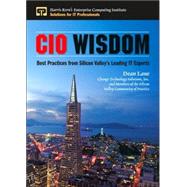
DEAN LANE is Senior Director of Information Technology at Symantec Corporation. Prior to joining Symantec, he served as a CIO four times at companies such as Plantronics, Masters Institute, and Allied Signal.
| Foreword | |
| Foreword | |
| Foreword | |
| Within and Beyond: Understanding the Role of the CIO | |
| The Extended Enterprise CIO | |
| Back to the Basics-What is a CIO? | |
| Women CIOs, by Judy Armstrong | |
| Why Single Out a Particular Group of CIOs? | |
| Why Is IT Unfriendly to Women? | |
| What Is IT Losing When Women Leave the IT Workforce? | |
| What Do We Need to Change to Attract More Women into the IT Profession | |
| Why Do Some Women Prevail and Others Do Not? | |
| What Is Different for Women CIOs in Their First 90 Days? | |
| Who Are Some of the Successful Women CIOs, and Why? | |
| The Value of Women in IT | |
| The First 90 Days | |
| Key Takeaways | |
| Overview | |
| Ninety-Day Tactical Plan | |
| IT Organization Review | |
| IT Strategic Plan | |
| IT Architecture Blueprint | |
| Management Recommendations | |
| Pulling It All Together | |
| The Tao Perspective | |
| An Indirect but Fundamental Approach | |
| CIO Challenges | |
| In Closing | |
| Communications: Communication Excellence in IT Management | |
| The Problem: Us Versus Them | |
| How to Break Down Stereotypes that Threaten Good Communication | |
| Essential Management Practices that Produce Good Communication | |
| What to Keep in Mind When Implementing Communication Tools and Practices | |
| How to Make Yourself a Better Communicator | |
| How to Know When Communication Is Good | |
| Conclusion | |
| IT Organization | |
| Challenges in Determining the Ideal IT Organization | |
| Centralized Versus Decentralized Organizational Structure | |
| Reflections on Critical Information Systems Functions | |
| Decisions and Topics Impacting the Organizational Model | |
| Final Comments on IT Organizations | |
| Governance | |
| The Paradox of IT | |
| The Role of the New CIO | |
| What Is Governance? Successful Governance | |
| Skills to Help You Govern | |
| Typical Governing Bodies | |
| Considerations Related to Governing Bodies | |
| Operational Governance | |
| Creating a Governance Model for Your Organization | |
| Putting a Governance Model in Place | |
| Managing Expectations for Governance | |
| How Much Energy Should Be Committed to Governance? Evolution of Governance | |
| Mistaken Uses of Governance | |
| Effect of Acquisitions on Governance | |
| Summary | |
| Architecture | |
| Are We Having Fun Yet? Overview | |
| The Classic Architecture Approach | |
| Enterprise Architecture Overview | |
| Planning for an Enterprise Architecture | |
| Component Architecture | |
| Multitier Architecture, Layer by Layer | |
| Developing a Strategic IT Portfolio | |
| Strategic Outsourcing | |
| Understanding Outsourcing | |
| Elements of Outsourcing | |
| Conclusion: Trends and Opportunities | |
| IT Workforce | |
| Five Basics for Retaining IT Professionals | |
| A Can-Do Attitude Cannot Be Beat | |
| Conclusions | |
| Strategic Planning | |
| Chapter Profile | |
| The CIO's Planning Role within the Business | |
| Business Strategizing | |
| Approaches to Setting | |
| Strategic Goals and Objectives | |
| IT Planning | |
| Steps to an IT Plan | |
| Managing to Plan an Ongoing/Evergreen Planning | |
| Milestones for Applications Portfolio Planning and Project Management | |
| Setting Priorities | |
| The Big Picture and Feedback Loop | |
| IT Infrastructure Management and Execution | |
| Table of Contents provided by Publisher. All Rights Reserved. |
The New copy of this book will include any supplemental materials advertised. Please check the title of the book to determine if it should include any access cards, study guides, lab manuals, CDs, etc.
The Used, Rental and eBook copies of this book are not guaranteed to include any supplemental materials. Typically, only the book itself is included. This is true even if the title states it includes any access cards, study guides, lab manuals, CDs, etc.